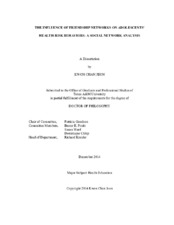| dc.description.abstract | Friendships among adolescents can exert significant influence on behaviors that pose risk to their health. However, empirical evidence for friendships’ influence is mixed due to various factors. Among these factors, are the complex mechanisms underlying friendship development (such as compliance with norms and beliefs that are encouraged and accepted by friends), as well as the use of traditional analytical methods for measuring the dynamic and complex mechanisms underlying the connection between friendships among adolescents and risky behaviors.
This dissertation addresses adolescents’ health risk behaviors and the influence of friendship network structures on their risky behaviors, using Social Network Analysis (SNA) as an analytic tool. The dissertation comprises two studies: The first one comprises a systematic literature review, focusing on studies of the influence of friendship networks on adolescents’ risky behaviors, which utilizes Social Network Analysis (SNA) and the Add Health data (a nationally representative sample). The review’s findings indicated that, across the studies assessed, having friends engaging in risky behaviors is a negative predictor of adolescents’ healthy behaviors. Moreover, the average methodological quality score (MQS) attributed to the reviewed studies was 4.5 (SD=1.4), an indicator of good quality (actual scores ranging from 2 to 7 points).
In the second study, we described the structure of friendship networks for adolescents who engage in, and for those who do not engage in sexual intercourse and alcohol consumption simultaneously. We also assessed the influence of the network’s structure upon adolescents’ simultaneous sexual intercourse and alcohol consumption. Among the two schools examined in this study, out-degree and betweenness centrality functioned as significant predictors of increased engagement in sexual intercourse and drinking alcohol in tandem for School 1. Also for School 1, adolescents’ age was associated with an increased risk for involvement in these simultaneous behaviors. In School 2, engagement in risky behaviors (sexual intercourse and alcohol consumption simultaneously) was significantly predicted by teens’ age and gender, but there were no effects of network attributes on adolescents’ risky behaviors.
Taken together, findings from these two studies contribute to better insights for developing intervention programs, especially programs targeting adolescents’ friendship networks. Additional research also is warranted to examine how peer influences impact behavior over time (longitudinal studies), and how multi-level characteristics (e.g., intrapersonal or interpersonal) might interact with network structure variables to affect adolescents’ risky health behaviors. | en |


